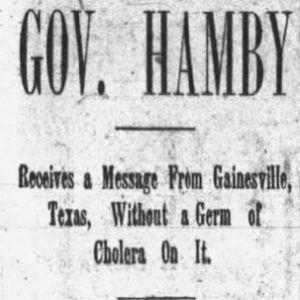calsfoundation@cals.org
Christopher Columbus Hamby (1851–1921)
Christopher Columbus Hamby of Prescott (Nevada County) was an attorney and political figure who served as acting governor of Arkansas for four months in the summer of 1892 during Governor James P. Eagle’s illness and absence from the state.
Born on September 14, 1851, in Calhoun County, Mississippi, C. C. Hamby was the son of Thomas Jefferson Hamby, a farmer who served in a Mississippi regiment of the Confederate army, and his wife, Nancy Elizabeth Byars. Because of the hardships during the Civil War, Hamby’s education was limited. He went to work as a brakeman for the Mississippi Central Railroad at the age of eighteen.
In 1872, Hamby moved to Logan County, Arkansas, where he attended school and worked on the farm of his uncle Micajah Hamby near Booneville. In 1874, he moved to Calhoun County, teaching school in Salem. He married Emma Frazier on November 25, 1875; his wife died in March 1876. During this period, Hamby had borrowed books from the firm of Bearden and Bunn in Camden and studied law in his free time. He was admitted to the Arkansas Bar in Camden (Ouachita County) in 1876. Hamby taught at New Edinburg (Cleveland County) from 1876 to 1877.
Hamby moved to Prescott (Nevada County), a new railroad town, opening a law office there in October 1878. He practiced alone until 1879 and then partnered with J. M. Montgomery, another local lawyer, until January 1886. In 1881, he was licensed to practice before the Arkansas Supreme Court and the federal courts. He married Isabella C. Blake of Prescott on February 6, 1881; they had one child. In December 1886, he moved his family to Texarkana (Miller County), where his wife died a few weeks later. On September 14, 1887, Hamby married Bettie Wells of Wallaceburg (Hempstead County), and they returned to Prescott. They had four children.
Hamby entered politics as a Democrat in 1890 and served as a state senator from the Twentieth Senatorial District (Hempstead and Nevada counties) for two terms from 1891 to 1893. Hamby was an early proponent of Jim Crow laws and introduced a bill requiring railroads “to provide and keep separate waiting and sitting rooms at each station for the white and colored races,” according to the January 29, 1891, Nevada County Picayune.
In 1891, Hamby was elected president of the Senate. With no constitutional provision for a lieutenant governor, he served as acting governor during Gov. Eagle’s illness in 1892. His tenure as acting governor was generally without great incident except for a cholera outbreak scare. The Arkansas Gazette complimented Hamby as acting governor.
From 1897 to 1909, Hamby served as the attorney of the Iron Mountain Railway in southwest Arkansas and was an official of the Citizens’ Bank, which was founded in Prescott in 1895. Having been a teacher, Hamby interested himself in education and was a member of the board of trustees of the University of Arkansas (UA) in Fayetteville (Washington County) for ten years beginning in 1897. In 1900, as evidence of his prosperity and position, he employed the architect Charles Thompson to build a large family home for him in Prescott; the home still stands today.
Hamby remained active in Democratic Party politics. He served on the State Central Committee from the Eighth Judicial Circuit in 1900. In the bitter fighting that divided the Arkansas Democratic Party, Hamby aligned himself with the Jeff Davis faction and chaired the Democratic State Convention at Hot Springs (Garland County) in 1904. On January 16, 1904, Davis got into a fistfight with his opponent, Judge Carroll D. Wood of the Arkansas Supreme Court, while appearing at Hope (Hempstead County). Both men were to come before the local police court for disturbing the peace, but Hamby appeared as Davis’s representative. Both men were fined by the mayor of Hope, and these shenanigans were reported as the state of Arkansas politics in the national press, as in the January 17, 1904, edition of the New York Times.
Hamby was not elected to a state office again. He lived and worked in the same town as the politically powerful and progressive future governor Thomas C. McRae. Hamby and McRae served together on the 1911 commission to build the Nevada County Courthouse, and Hamby was president of the school board in Prescott for years. Aside from these local offices, however, his political career at the state level was over.
In early 1921, Hamby suffered a stroke while hunting alone and lay outside for twelve hours in bitter cold weather before he was found by search parties. After being rescued, he appeared to rally but died on January 31, 1921. He is buried in the Old Section of De Ann Cemetery at Prescott.
For additional information:
Biographical and Historical Memoirs of Southern Arkansas. Chicago: Goodspeed Publishing Co.,1890.
Donovan, Timothy P., Willard B. Gatewood Jr., and Jeannie M. Whayne, eds. The Governors of Arkansas: Essays in Political Biography. 2nd ed. Fayetteville: University of Arkansas Press, 1995.
Herndon, Dallas T. Centennial History of Arkansas. 3 vols. Chicago: The S. J. Clarke Publishing Co., 1922.
Nevada County Depot and Museum. http://depotmuseum.org (accessed April 6, 2022).
Reynolds, John Hugh, and David Yancey Thomas. History of the University of Arkansas. Fayetteville: University of Arkansas, 1910.
Peggy S. Lloyd
Southwest Arkansas Regional Archives
 Post-Reconstruction through the Gilded Age, 1875 through 1900
Post-Reconstruction through the Gilded Age, 1875 through 1900 Governor Vacancy Article
Governor Vacancy Article  Hamby Cholera Concern
Hamby Cholera Concern 




Comments
No comments on this entry yet.